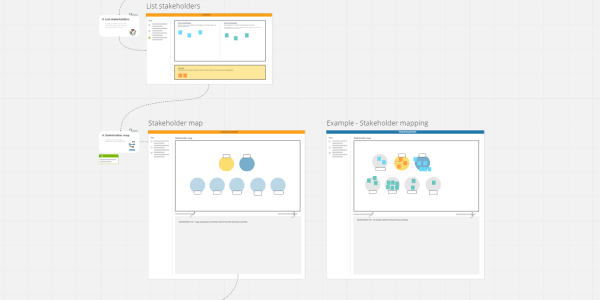Find support
Because a stakeholder map is an overview, you don’t need to ensure you have all the subject matter experts for all parts of the service in the room at the same time. In fact, that might be counterproductive. Instead, try to find the balance between a small enough team and enough breadth of knowledge so that you can be somewhat confident that your first attempt at a stakeholder map is close. Don’t aim for perfect.
Invite your participants
Aim for including a range of people to form a multi-disciplinary team. Participants in this session should be made up of the project team and any subject matter experts relevant to the project. This might include a Project Manager (PM), Project Officer, Designer, Business Analyst, Communications Officer, Solution Architect, or Developer. You can still run the session if you don't have all of these team members available but aim for as much diversity as possible.
You’ll want to make sure when you send an invite for the session, that you clearly explain the goal, how long it’ll take, and why people’s participation will be beneficial. You can use the provided template to make it easy.
It’s important to give enough notice to ensure participants have free time to come along to the session. Aim to send invitations about 2 weeks in advance.
You can also attach the play for people to look at ahead of time.
Calendar meeting request for stakeholder mapping
Subject:
Join us to create a stakeholder map for [project name]
Meeting description:Hi [team name if sending a group invitation, or participant name if sending individual invitations]
As part of our project kick-off
, we’ll be running a stakeholder mapping workshop to identify our stakeholders and the relationship between them in order to communicate with them more effectively. Having you attend will help us to identify the stakeholders across the different stages of our [product/service].
The session will take about [60] minutes and there is no preparation required.
We will be using Miro for this workshop and you can read more about stakeholder mapping in the Digital service design playbook.
I look forward to your contribution to the session.
Kind Regards,
[Facilitator name]
Setting up the tools
For remote teams, use the Miro template provided.
For in-person teams, you will need a booked meeting space, sticky notes (one pad per participant), markers (one for each participant) and a whiteboard, wall or butcher paper to attach the sticky notes. Even if you are working in-person, consider reviewing the Miro template to get an idea of how we suggest running the Play.




